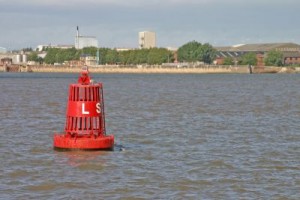 The Intracoastal Waterway runs parallel to the Atlantic and Gulf Coasts from Manasquan Inlet on the New Jersey shore to Brownsville, Texas at the Mexican border. Aids to navigation marking these waterways have some portion of them marked with yellow. Otherwise, the colors and numbering of buoys, day marks and lights follow the same system as that observed in all other waterways.
The Intracoastal Waterway runs parallel to the Atlantic and Gulf Coasts from Manasquan Inlet on the New Jersey shore to Brownsville, Texas at the Mexican border. Aids to navigation marking these waterways have some portion of them marked with yellow. Otherwise, the colors and numbering of buoys, day marks and lights follow the same system as that observed in all other waterways.
Red, right, returning also applies to the Intracoastal Waterway markers. However, it is imperative to know which way is returning? Generally south, from New Jersey to Brownsville, Texas is considered returning. So, going generally south on the Intracoastal Waterway that you would have red right. There are some areas of the Intracoastal Waterway such as the West Coast of Florida where you are actually going north. Still, if you are going from New Jersey to Texas you are returning.
Yellow triangles indicate aids should be passed by keeping them on the starboard side of the vessel. Yellow squares indicate aids should be passed by keeping them on the port side of the vessel. A yellow horizontal band has no lateral significance, but simply identifies aids as marking the ICW.
Dual purpose markings include: red Buoy with yellow square — marks left side of channel when traveling the Intracoastal Waterway (south), but right side of channel when coming in from sea; green Buoy with yellow triangle — marks right side of channel when traveling the Intracoastal Waterway (south), but left side of channel when coming in from sea; red buoy with yellow triangle — marks right side of channel when traveling the Intracoastal Waterway (south), and right side of channel when coming in from sea; green buoy with yellow square — marks left side of the channel when traveling the Intracoastal Waterway (south), and left side of channel when coming in from sea.
Green colors and lights should be on your right or starboard when traveling toward open waters. Red colors and lights should be on your right side or starboard when traveling toward the channel. Red and white vertically striped buoy markers, some topped with a white light or red top mark, indicate mid-channels or fairways. These markers may be passed on either side as long as other, safe navigation rules are followed. Red and Green buoys and lights indicate primary channels. If the green horizontal band is on top, the primary channel is the right (starboard). If the red band is on the top, the primary channel is to the left (port) side. This marker indicates the primary channel is on the starboard.
Shapes of buoys, numbers and letters play key roles in the lateral system. Generally, green port side buoys in the main and secondary channels are “can” or square-shaped markers and odd-numbered. Red starboard side buoys in these channels are “nun” or triangular-shaped markers and even-numbered. Inland waters obstruction markers are white with black stripes. You should not pass between these buoys and the shore. Navigational markers also may be black and/or white, red and/or white, numbered or lettered, indicating locally-placed or outdated navigational systems. Yellow buoys indicate special markings such as traffic separations, international boundaries, anchorage areas, dredging, fish net area, etc.
Boating is a favorite pastime in Texas. Boating safety is imperative on all waterways. All boaters should make it a priority to understand the navigational markers before venturing out on their vessel. Safe boaters are happy boaters.
Source: “Boater Education.” TPWD: Buoys and Marker. Web. 30 Jan. 2013.
Follow Us: Facebook – Foursquare – Twitter – YouTube – LinkedIn
